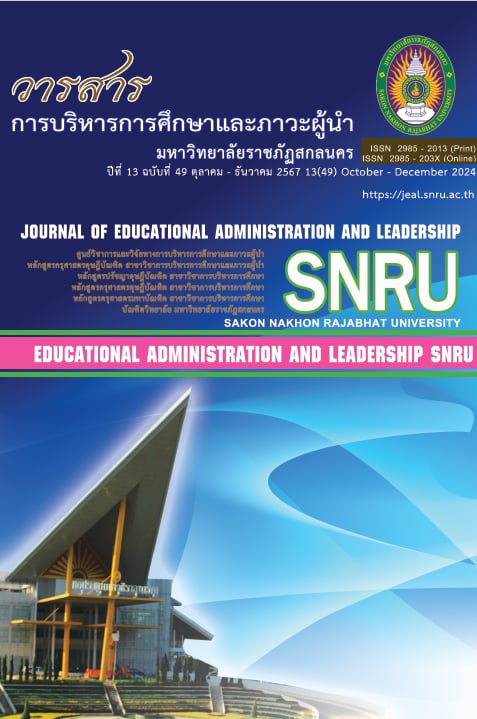

ความสัมพันธ์ระหว่างภาวะผู้นำเชิงกลยุทธ์ของผู้บริหารกับการมีส่วนร่วมในการบริหารงานของครูในโรงเรียน สังกัดสำนักงานเขตพื้นที่การศึกษาประถมศึกษานครพนม เขต 2
The Relationship between Strategic Leadership of Administrators and Teachers’ Participation in School Administration in Schools Under Nakhon Phanom Primary Educational Service Area Office 2
ผู้แต่ง
ทวีศักดิ์ แก้วยวน, ไชยา ภาวะบุตร, ประภัสร สุภาสอน
Author
Taweesak Kaewyuan, Chaiya Pawabutra, Praphat Supasorn
บทคัดย่อ
การวิจัยครั้งนี้มีความมุ่งหมายเพื่อ 1) ศึกษาภาวะผู้นำเชิงกลยุทธ์ของผู้บริหาร และการมีส่วนร่วมในการบริหารงานของครู 2) เปรียบเทียบภาวะผู้นำเชิงกลยุทธ์ของผู้บริหารโรงเรียน และการมีส่วนร่วมในการบริหารงานของครู จำแนกตามสถานภาพการดำรงตำแหน่ง ขนาดของโรงเรียน และประสบการณ์ในการปฏิบัติงานที่ต่างกัน 3) ศึกษาความสัมพันธ์ระหว่างภาวะผู้นำเชิงกลยุทธ์ของผู้บริหารกับการมีส่วนร่วมในการบริหารงานของครู และ 4) หาแนวทางการพัฒนาภาวะผู้นำเชิงกลยุทธ์ของผู้บริหารที่มีความสัมพันธ์กับการมีส่วนร่วมในการบริหารงานของครู ประชากรคือ ผู้บริหารโรงเรียน และครูผู้สอน สังกัดสำนักงานเขตพื้นที่การศึกษาประถมศึกษานครพนม เขต 2 ปีการศึกษา 2566 จำนวน 1,694 คน จำแนกเป็นผู้บริหารโรงเรียน จำนวน 181 คน และครูผู้สอน จำนวน 1,513 คน จากทั้งหมด 181 โรงเรียน การกำหนดขนาดของกลุ่มตัวอย่างใช้ตารางของ Krejcie and Morgan ได้กลุ่มตัวอย่างวิจัยครั้งนี้ จำนวน 336 คน วิธีสุ่มตัวอย่างใช้การสุ่มแบบหลายขั้นตอน เครื่องมือที่ใช้ในการเก็บรวบรวมข้อมูลเป็นแบบสอบถามชนิดมาตราส่วนประมาณค่า 5 ระดับ เป็นแบบสอบถามข้อมูลเกี่ยวกับภาวะผู้นำเชิงกลยุทธ์ของผู้บริหาร มีค่าอำนาจจำแนกอยู่ระหว่าง 0.37 - 0.86 และค่าความเชื่อมั่นเท่ากับ .94 และแบบสอบถามข้อมูลเกี่ยวกับการมีส่วนร่วมในการบริหารโรงเรียนของครู มีค่าอำนาจจำแนกอยู่ระหว่าง 0.61 - 0.90 และค่าความเชื่อมั่นเท่ากับ 0.97 และใช้แบบสัมภาษณ์เชิงลึกเพื่อการศึกษาเชิงคุณภาพ สถิติที่ใช้ในการวิเคราะห์ข้อมูล ได้แก่ ร้อยละ ค่าเฉลี่ย การวิเคราะห์ค่าสหสัมพันธ์อย่างง่ายของเพียร์สัน และการทดสอบค่าที ผลการวิจัยพบว่า 1. ภาวะผู้นำเชิงกลยุทธ์ของผู้บริหาร และการมีส่วนร่วมในการบริหารงานของครู โดยรวม อยู่ในระดับมาก 2. ภาวะผู้นำเชิงกลยุทธ์ของผู้บริหารโรงเรียน จำแนกตามสถานภาพการดำรงตำแหน่ง และขนาดของโรงเรียน พบว่า โดยรวม แตกต่างกันอย่างมีนัยสำคัญที่ระดับ .05 และประสบการณ์ในการปฏิบัติงาน โดยรวม พบว่า แตกต่างกันอย่างมีนัยสำคัญทางสถิติที่ระดับ .01 และการมีส่วนร่วมในการบริหารงานของครู จำแนกตามสถานภาพการดำรงตำแหน่ง พบว่า โดยรวม พบว่า แตกต่างกันอย่างมีนัยสำคัญที่ระดับ .05 ในส่วนขนาดของโรงเรียน โดยรวม พบว่า แตกต่างกันอย่างมีนัยสำคัญที่ระดับ .01 และประสบการณ์ในการปฏิบัติงาน พบว่า ไม่มีความแตกต่างกัน 3. ความสัมพันธ์ระหว่างภาวะผู้นำเชิงกลยุทธ์ของผู้บริหารกับการมีส่วนร่วมในการบริหารงานของครูโดยภาพรวมมีความสัมพันธ์กันทางบวกในระดับสูง อย่างมีนัยสำคัญทางสถิติที่ระดับ .01 โดยมีค่าสัมประสิทธิ์สหสัมพันธ์ .840 4. ทางเลือกการพัฒนาความสัมพันธ์ระหว่างภาวะผู้นำเชิงกลยุทธ์ของผู้บริหารโรงเรียนกับการมีส่วนร่วมในการบริหารงานของครู ในด้านที่ต้องนำไปหาแนวทางพัฒนา 6 ด้าน สรุปได้ดังนี้ 1) ด้านความคาดหวัง และสร้างโอกาสสำหรับอนาคต คือ ผู้บริหารสถานศึกษาสามารถวางแผน และกำหนดเป้าหมายในการพัฒนาสถานศึกษาอยู่ตลอดเวลา 2) ด้านความคิดเชิงปฏิวัติเพื่อการเปลี่ยนแปลง คือ ผู้บริหารสถานศึกษาความสามารถคิดแบบองค์รวมในการเชื่อมโยงเรื่องที่มีความสัมพันธ์เชิงเหตุผลในการกำหนดวิสัยทัศน์ พันธกิจและเป้าหมาย 3) ด้านการกำหนดวิสัยทัศน์เชิงสร้างสรรค์ คือ ผู้บริหารสถานศึกษาสามารถกำหนดทิศทางการศึกษา โดยการวิเคราะห์สภาพแวดล้อมตามบริบทของสถานศึกษา 4) ด้านการมีส่วนร่วมในการตัดสินใจ คือ ผู้บริหารสถานศึกษามีส่วนร่วมในการประชุม พิจารณาในการจัดทำหลักสูตร การกำหนดวิสัยทัศน์ พันธกิจ เป้าประสงค์ของสถานศึกษา 5) ด้านการมีส่วนร่วมในการปฏิบัติการ คือ ผู้บริหารสถานศึกษามีส่วนร่วมกำหนดนโยบาย กำหนดแผนปฏิบัติการ กำหนดหลักสูตรสถานศึกษา เพื่อพัฒนาสถานศึกษาอย่างเป็นระบบและต่อเนื่อง และ 6) ด้านการมีส่วนร่วมในผลประโยชน์ คือ ผู้บริหารสถานศึกษามีส่วนร่วมในการจัดทำกิจกรรมโครงการพัฒนาในสถานศึกษา และเสนอแนะการดำเนินงานจัดทำกิจกรรมโครงการ
Abstract
The purposes of this research were to 1) examine administrators’ strategic leadership and school administration participation of teachers, 2) compare administrators’ strategic leadership and school administration participation of teachers, classified by positions, school sizes, and work experience; 3) determine the relationship between administrators’ strategic leadership and school administration participation of teachers; and 4) establish guidelines for developing administrators’ strategic leadership and school administration participation of teachers. The population comprised 181 administrators and 1,513 teachers under Nakhon Phanom Primary Educational Service Area Office Area 2 during the academic year 2023, totaling 1,694 participants. The sample size was determined using Krejcie and Morgan's table, and multi - stage random sampling, yielding a total of 336 participants. The tool for data collection was a 5 -level rating scale questionnaire regarding strategic leadership of school administrators with the discriminant power values ranging between .37 and .86 and the reliability of .94 and the school administration participation of teachers with the discriminant power ranging between .61 and .90 and the reliability of .97. The results of the research were as follows: 1. The strategic leadership of administrators and the school administration participation of teachers were overall at a high level. 2. The strategic leadership of administrators, classified by positions and school sizes, overall showed differences at the .05 level of significance. Differences in strategic leadership regarding work experience were different at the .01 level of significance. The school administration participation of teachers was overall at the .05 level of significance in terms of positions. Regarding school sizes, there were significant differences at the .01 level, whereas no differences in terms of work experience were observed. 3. Overall, there was a highly positive relationship between the strategic leadership of administrators and school administration participation of teachers at the .01 level of significance with a correlation coefficient of r = .840. 4. The alternatives for developing the relationship between strategic leadership of administrators and teachers’ participation in school administration encompassed six aspects requiring improvement: 1) Expectations and Creating Future Opportunities: Administrators are advised to commit to continuously planning and establishing school development goals; 2) Revolutionary Thinking for Change: Administrators should possess holistic thinking abilities to connect related matters logically when formulating vision, mission, and goals; 3) Establishing a Creative Vision: Administrators are advised to guide educational direction by analyzing the school environment condition following school contexts; 4) Participation in Decision Making: Administrators actively engage in meetings to contribute to curriculum preparation and the formulation of school vision, mission, and goals; and 5) Participation in School Operations. Administrators are advised to participate in setting policies, action plans, and school curricula to develop educational institutions, and 6) Encouraging Participation in Benefits: Administrators actively participate in organizing development project activities within schools.
คำสำคัญ
ภาวะผู้นำเชิงกลยุทธ์, การมีส่วนร่วมในการบริหารKeyword
Strategic Leadership of School Administrators, Teachers’ Participation in School AdministrationNotice: Undefined variable: dataSet in /var/www/html/ArticleView.php on line 116
Notice: Trying to access array offset on value of type null in /var/www/html/ArticleView.php on line 116
บทความทุกบทความเป็นลิขสิทธิ์ของ
Notice: Undefined variable: dataSet in /var/www/html/ArticleView.php on line 116
Notice: Trying to access array offset on value of type null in /var/www/html/ArticleView.php on line 116
เท่านั้น
กำลังออนไลน์: 8
วันนี้: 0
เมื่อวานนี้: 955
จำนวนครั้งการเข้าชม: 750,734
อาคารบัณฑิตวิทยาลัย ชั้น 2 ตำบลธาตุเชิงชุม อำเภอเมือง จังหวัดสกลนคร 47000
โทร/
แฟกซ์ 0-4297-0093
บรรณาธิการ: รองศาสตราจารย์ ดร.ไชยา ภาวะบุตร
ติดต่อ/สอบถาม: นายธีรเวทย์ เพียรธัญญกรณ์
โทร: 0-4297-0093